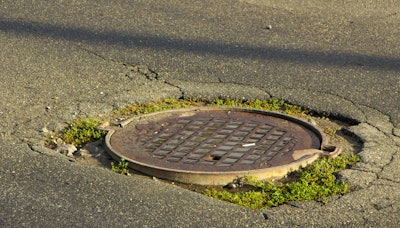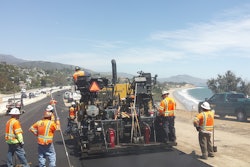
Manholes are as safe and secure as the surrounding roadway. Unfortunately, the American Society of Civil Engineers reported in its 2021 report card that 43% of the public roadways in the U.S. are in poor or mediocre condition. This figure is particularly concerning given the millions of people traveling every day – to work or vacation, to distribute goods and services, and general day-to-day travel within local communities. In any given city or suburb, there are manholes approximately every 300 feet of roadway. That means there are many opportunities for potential gotchas: bumps, dips, mounds and cracks in asphalt or tilted manhole rims – every time one drives along a poorly maintained road.
As John Hickey, executive director of the Asphalt Pavement Association of Oregon puts it, “Go out on any road and the chances are high that you will see a manhole that does not match the surrounding pavement. When a manhole isn’t at the right elevation -- if it’s too low, too high, or angled incorrectly -- it’s difficult to compact the surrounding asphalt correctly. That asphalt is going to fail way earlier than all the other asphalt on the road, which will create a long-term repair nightmare.”
The costly impacts associated with poorly installed or maintained manholes vary greatly, and not all are as evident as the feeling of hitting a bump in the road. Most obvious are the direct costs of having to repair road damage, including the labor costs associated with breaking up pavement, releveling the manhole and having to re-pave around it – due to the entirely preventable issues Hickey mentions above. But there are also many hidden costs of bad manholes that should be considered, and construction crews need to be given the proper tools to do it right – and safely – the first time.
Asphalt Integrity
According to the National Asphalt Paving Association, 93% of America’s paved roads are surfaced with asphalt. When newly laid and perfectly leveled, asphalt should last anywhere from 15-20 years. When cracks and premature road wear develop around a utility but not in the main sections of a roadway, however, that’s typically an issue with the utility cover’s elevation (e.g. too low, too high, tilted incorrectly) and maintenance is going to be required more frequently. Bad manhole installations lead to cracks developing around utility covers, causing leakage into the manhole, as well as creating dips, mounds or bumps that lead to further asphalt damage over time, ultimately resulting in the need to repave roads.
A straight section of road with no curbs is an easy paving job. But throw in some variables, and things get tricky. When complex intersections are involved – including multiple underground utilities, automatic grade controls, intersections with ADA compliance, draining requirements, curbs, milled or overlayed surfaces or any other variables – paving around utilities becomes a lot more complex, and the more important it is to get it right the first time. In short, the more precisely a manhole cover matches the designed pavement elevation, the longer the pavement will last. If we want our roads built for longevity, manhole leveling should be part of a standardized process of laying asphalt so it’s precisely to grade every time for optimal integrity.
Worker Safety
Skillfully laying asphalt around manholes might be relatively straightforward work for the highly experienced construction crew, but with today’s employment challenges, many people working on roads are not as experienced; and lack of standardized methods and processes in construction can easily lead to injury. As reported in Construction Executive, U.S. Bureau of Labor and Statistics data shows that 34.9% of new, untrained workers in the construction industry are injured during their first year on the job.
Hickey also noted the uptick in unskilled workers. “There are experienced crew members who can pave really well, but those people are becoming fewer and farther between. Left with inexperienced crews, there is an increased risk of quality issues and injuries.”
This should be a red flag for construction management, warranting a new look at current training procedures, determining where hazards may occur, and creating simpler, safer systems and standards that are precise and easier for crews to manage.
When it comes to manhole maintenance, construction crews are largely using the age-old method of manually raising them to grade using pry bars and shims. In addition to being less precise, this manual shimming process can easily result in back and hand injuries, among others. And because manhole leveling can be last in the paving process, it’s often in the back of a foreman’s mind in terms of priority. Rushing to get the job done, particularly when relying on less experienced crews and outmoded manual methods, creates even more of a safety hazard for workers.
As Hickey states, “Achieving a high degree of accuracy setting manholes and matching the surrounding grades using traditional methods can be difficult, and often involves multiple people, more time and more safety risk.”
Relying on “we’ve always done it that way” will continue to result in both poorer pavement quality and worker injuries. But there are newer alternatives that don’t require multiple people, back-breaking lifting or imprecise hand placements to raise manholes to grade. Bolt- or screw-adjusted leveling systems, like RimRiser, are far more precise while also being simpler, faster and safer to use for workers of any skill level. With these systems now readily available, engineers can design in safety by creating specifications for manhole leveling that both support crew safety and result in higher quality paving.
Equipment and Vehicle Damage
Uneven manhole covers can become costly problems for contractors and the municipalities that hire them. Asphalt layers, sweepers and milling machines, for example, can take a beating. If an asphalt-spreading auger hits the metal side of an uneven manhole, the result can be a costly repair or replacement of the auger itself and/or the gearbox that controls it. Not only is this a hard cost of thousands of dollars’ worth of equipment, the costly delays in road repair schedules and the domino effect of costs this creates should also be acknowledged. What are the costs when citizens lose hourly wages or miss important deadlines or appointments due to surprise traffic stops and detours? What about the toll this takes on vehicles, when off-kilter manhole rings damage tires, crack rims and damage suspension systems? What about motorcyclists who sometimes weave in and out of traffic? For them, catching an edge of a manhole can be deadly, or at a minimum lead to driver accidents and injuries. The bottom line is, it’s important to set manholes correctly the first time to reduce surprise costs and delays.
Environmental Impacts
As the climate warms and creates more severe weather, damage to roads will become more commonplace. Extreme weather events affect the integrity of roads – including manholes – in numerous ways, such as softening, expansion, rutting, cracking and crumbling. In 2017, 47% of manholes were flooded due to intense rainfall, sometimes leading to sewage spills as well as infrastructure damage. Cities must plan effectively to ensure manholes have modernized infrastructure, with safe and effective drainage systems and proper maintenance plans to prepare for the inevitable weather events to come. And as we plan to use fewer resources in smarter ways to protect our environment, we must consider the impacts of frequent repairs due to poor initial installations and put systems in place to do it right the first time.
When all is well, drivers don’t notice manholes or think about the underground infrastructure holding together communities. The fact that most manholes are almost one hundred years old, and that many – even the newer ones – are raised to road level using shims made of bricks, concrete, or other odds and ends in a contractor’s bucket of shims, should be alarming. It certainly makes a strong case to upgrade and modernize current manholes and the systems used to install, level them to grade and maintain them over time.
The many costs of bad manholes are borne by road builders, contractors, municipalities, insurance companies, drivers and taxpayers. There is no reason for this when there are simple solutions available to help ensure that manholes are set right the first time.
Aaron Barr is the founder and CEO of RimRiser. After more than 30 years working in the field as a contractor, developer and craftsman, Barr developed and perfected the RimRiser bolt-adjusted technology that is now being used in projects nationwide. RimRiser-ready cast iron frames/rings and precast concrete tops/lids provide a simpler, safer and more accurate way to precisely level civil infrastructure in paved surfaces. Contact Aaron at [email protected], visit www.RimRiser.com or call 360-833-2277.











![Lee Boy Facility 2025 17 Use[16]](https://img.forconstructionpros.com/mindful/acbm/workspaces/default/uploads/2025/09/leeboy-facility-2025-17-use16.AbONDzEzbV.jpg?ar=16%3A9&auto=format%2Ccompress&fit=crop&h=135&q=70&w=240)








